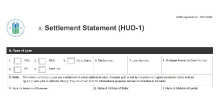CARL WATTS & ASSOCIATES
May 24, 2010
What is HUD-1?
The Real Estate Settlement Procedures Act (RESPA) requires that a standard real estate settlement form be used in all transactions which involve federally related mortgage loans - that form is HUD-1.

|
Washington DC
|
tel/fax 202 350-9002 |
Settlement Statement

|
First Page
|
|
| Sections A through I contain basic information. |
|
| Sections J is a summary of the borrower’s transactions. |
|
|
The amount owed by the borrower in sub-section 100 is determined by the price of the property, fees, settlement charges, taxes prepaid by the seller and any extra items on the property (e.g. kitchen appliances).
|
|
|
Sub-section 200 contains money already paid by the borrower for the purchase of he property (deposit, financing, unpaid taxes, repairs). |
|
|
Sub-section 300 reflects the actual amount of cash the borrower must have at he time of the settlement. |
|
|
REMEMBER
|
|
|
Consider settlement fees before making your purchase offer |
|
|
Negotiate the terms of your settlement (which party pays certain fees) and have all your negotiations in writing. |
|
|
Some settlements costs, such as insurance, may be higher if your credit rating is low; in most areas of the country the settlement costs will be about 3% of the price of the home. |
|
|
Some costs may be reduced by shopping around for settlement services. |
|
|
Accuracy is of utmost importance on the Settlement Statement so please revise carefully, double check all figures and don‘t hesitate to ask questions.
|
|

|
Settlement Charges - Section L |
|
|
Sub-section 700 deals with the commission paid to real estate agencies (usually from the seller’s funds). |
|
|
Sub-section 800 contains all the fees associated with the home loan, typically paid by the borrower; these will not reflect in the total charges for the settlement (line 1400). |
|
|
Sub-sections 900 and 1000 show what needs to be paid before the settlement and the escrow items (for future expenses) respectively. |
|
|
Title charges in sub-section 1100 reflect money due for legally changing the ownership of the property, including payments to attorneys and notaries, while sub-section 1200 shows charges payable to the city, county or state and the deed fee which is usually paid by the borrower. |
|
| Additional charges in sub-title 1300 may include home inspections, surveying or warranties. |
|
|
The actual costs and fees should be com-pared with the Good Faith Estimate which is documented on a form similar to the HUD-1 and provided by the lender to the borrower within three days of loan application.
|
|
|
Section K contains the gross amount due to the seller as well as adjustments made for items paid in advance. |
|
| Some entries in these sections reflect the detailed information in Section L on the following page. |